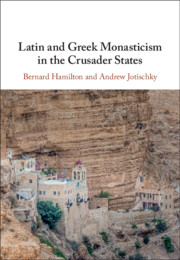Book contents
- Latin and Greek Monasticism in the Crusader States
- Latin and Greek Monasticism in the Crusader States
- Copyright page
- Contents
- Figures
- Abbreviations
- Acknowledgements
- Maps
- Introduction
- Part I Latin Monasticism
- 1 The Latin Presence in the Levant before 1097
- 2 The Austin Canons
- 3 The Premonstratensian Canons
- 4 The Canons Regular of St Ruf, Avignon, in the County of Tripoli
- 5 Benedictine Monasteries
- 6 Benedictine Convents
- 7 Benedictine Monasteries in the Tradition of St Romuald and St Peter Damian
- 8 The Cistercians
- 9 The Carmelites
- 10 The Franciscan Provincia Terrae Sanctae
- 11 The Dominican Provincia Terrae Sanctae
- 12 Antiochene Monasteries of Uncertain Rite
- Part II Greek Orthodox Monasticism
- Select Bibliography
- Index
1 - The Latin Presence in the Levant before 1097
from Part I - Latin Monasticism
Published online by Cambridge University Press: 08 October 2020
- Latin and Greek Monasticism in the Crusader States
- Latin and Greek Monasticism in the Crusader States
- Copyright page
- Contents
- Figures
- Abbreviations
- Acknowledgements
- Maps
- Introduction
- Part I Latin Monasticism
- 1 The Latin Presence in the Levant before 1097
- 2 The Austin Canons
- 3 The Premonstratensian Canons
- 4 The Canons Regular of St Ruf, Avignon, in the County of Tripoli
- 5 Benedictine Monasteries
- 6 Benedictine Convents
- 7 Benedictine Monasteries in the Tradition of St Romuald and St Peter Damian
- 8 The Cistercians
- 9 The Carmelites
- 10 The Franciscan Provincia Terrae Sanctae
- 11 The Dominican Provincia Terrae Sanctae
- 12 Antiochene Monasteries of Uncertain Rite
- Part II Greek Orthodox Monasticism
- Select Bibliography
- Index
Summary
A Latin monastic presence was part of the landscape of the Holy Land as early as the fourth century. Although the Latin presence waned after the Arab Conquest of the seventh century, interest and involvement in the monastic presence of the Holy Land continued, notably in the reign of Charlemagne in the early ninth century. The eleventh century saw increased knowledge of conditions for Christians in the Holy Land as pilgrimage from the West became more widespread. By the eve of the First Crusade in 1095, the Latin and Greek Orthodox Churches had drifted apart in observance of religious customs, but they remained in communion. The purpose of the Crusade was to revive and strengthen the Christian presence in the Holy Land.
- Type
- Chapter
- Information
- Latin and Greek Monasticism in the Crusader States , pp. 11 - 21Publisher: Cambridge University PressPrint publication year: 2020

